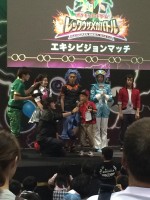Pokemon Getto Da Ze! – Playing Pokemon in Japan!
Intro
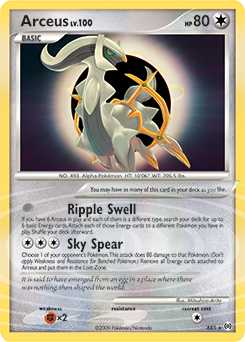
Hey there, Pokemon Masters! My name is Michael Stephens. Those of you who have been following the recent Bandit Ring leaks may recognize me as part of the translation team here at PokeBeach, but today I make my first foray into the article side of the stadium. Before I launch into the bulk of that, let me quickly introduce myself and my history in the game.
I’ve been playing the Pokemon TCG since its initial US release in 1999, and doing so competitively since Nintendo’s reclamation of the game from Wizards of the Coast in 2003. I was a fairly skilled player in the Seniors age division, earning World Championship invites from 2004-2006 and finishing in the top 32 in 2004, as well as top 8 at US Nationals in 2006. Though, I still maintain that my greatest achievement of that time was consistently winning Pre-Releases and ranking #1 in the world in Limited for most of the time when Limited was a ranked format. Upon moving up to Masters, the combination of increased competition and decreased free time led to a decline in my tournament performance, and my biggest victory in that age division was taking home 2nd and 3rd place 2010 State Championship trophies with an Arceus deck, which was widely regarded as a mostly-unplayable gimmick. I don’t have nearly as many victories under my belt as our other writers here, but what I do have is a fairly unique perspective among the English-speaking TCG community: a first-hand look at the Japanese tournament structure and metagame. I’ve been living in Japan and working as an English Language Teacher since last August, and today I’d like to tell you all about my experiences in Japan’s version of Organized Play this year, with a particular focus on the recent Rayquaza Mega Battle in Osaka.
Overview of Japan’s Organized Play
First, let’s take a look at what “Organized Play” in Japan looks like, because it’s very, very different from what we in the West are familiar with. When I went to Worlds, I was always very surprised – and I doubt I’m the only one who has been – by how few Japanese players were present, considering that they have one of the largest player bases in the world (behind the US), not to mention the fact that they invented the game. This disparity of Worlds invites is largely due to the substantial difference in OP structure. There is no Championship Point system in Japan, and invites can only be acquired through victory at certain tournaments – a format that the US also experimented with long before the current ranking system. Even in those days, however, invitations were much more plentiful in the US, because qualifying tournaments included Gym Challenges, at least one of which was held in every single state. Qualification criteria in Japan, on the other hand, has generally been limited to the top players at only the year’s most prestigious tournament. This year, that means Worlds invites will go to the top 4 players in each of Japan’s two age divisions at the Japan Championship, to be held June 27th-28th. But we’re getting a bit ahead of ourselves, let’s start from the bottom and work our way up to that.
As a quick aside, though, you may have noticed something strange near the end of that paragraph, but I assure you that you read that correctly: Japan has only two age divisions, in contrast to the rest of the world’s three. In Japan, the age divisions are the A League, which is open to Elementary School students only; and the B League, which is open to Junior High School students and older. Essentially, this means the Seniors age division does not exist, forcing young players to adapt to an adult-filled competitive environment much earlier in their career. This may partially explain why, despite sending such a small contingent, Japan consistently places very highly at the World Championships.
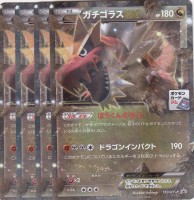 Now then, at the bottom end of Japan’s Organized Play are the thematically named Gym Battle tournaments. These are roughly equivalent to your local league tournaments: they can be held anywhere certified to host them (usually card shops and book stores), they’re officially sanctioned by Organized Play, and they receive exclusive promotional items; but doing well at them isn’t going to get you any points, glory, or serious swag. Participants receive either promo packs (this is how the recent Flygon-EX and upcoming Tyrantrum-EX, for example, were distributed in Japan) or exclusive card sleeves, with the prizes for those who place well being merely a larger quantity of the participation prize. Occasionally these tournaments will be specially themed, like the upcoming Umbreon Night Battle, where players can receive the Umbreon and All-Night Party promo cards. Gym Battles held in the month before a bigger tournament award the winners with certificates which essentially allow them to skip a stage at one of those bigger tournaments (more on this later), but this is the rare exception to a prize structure generally composed of cool sleeves and binder-fodder.
Now then, at the bottom end of Japan’s Organized Play are the thematically named Gym Battle tournaments. These are roughly equivalent to your local league tournaments: they can be held anywhere certified to host them (usually card shops and book stores), they’re officially sanctioned by Organized Play, and they receive exclusive promotional items; but doing well at them isn’t going to get you any points, glory, or serious swag. Participants receive either promo packs (this is how the recent Flygon-EX and upcoming Tyrantrum-EX, for example, were distributed in Japan) or exclusive card sleeves, with the prizes for those who place well being merely a larger quantity of the participation prize. Occasionally these tournaments will be specially themed, like the upcoming Umbreon Night Battle, where players can receive the Umbreon and All-Night Party promo cards. Gym Battles held in the month before a bigger tournament award the winners with certificates which essentially allow them to skip a stage at one of those bigger tournaments (more on this later), but this is the rare exception to a prize structure generally composed of cool sleeves and binder-fodder.
The play format for Gym Battles is more or less completely up to the tournament organizer: I’ve been to some Gym Battles that were BW-On and others that were XY-On, some that were Single Elimination and some that had Swiss Rounds. In one case, I even participated in a Swiss-style tournament where, unbeknownst to me until the end, your standing was calculated not by wins and losses but by the differential of prizes you took vs prizes taken against you. As you can see, while these tournaments are technically part of Organized Play, they’re pretty informal.
So, what comes next after these local league-level Gym Battle Tournaments? Something equivalent to a Battle Road? A City Championship? A State Championship? Nope, nope, nope. The next step up is no less than the equivalent of a Regionals, size- and prestige-wise. A far cry from the constant stream of CP-earning events we have in the West, Japan holds only two series of truly competitive tournaments every year (once in the fall and once in the spring), with less than half a dozen dates and locations for each series. This year, the fall tournaments were known as Battle Festa 2014, and the spring tournaments were the Rayquaza Mega Battles. Japan might not have big tournaments very often, but when they do, they go all-out, and while they’re comparable to Regionals in size, these events are truly unlike anything that exists in Western OP.
For the most part, the fall and spring events are nearly identical in format and structure, so the following account of Osaka’s Rayquaza Mega Battle should give you a feel for what they’re all like. There is one major difference between the two series, however. Place first or second at the Battle Festa? Congrats, here’s a Victory Ring promo card. Place first or second at the Rayquaza Mega Battle? Here’s a Victory Ring promo card… and an invitation to the aforementioned Japan Championship, the singular road to Worlds for Japanese players. Unlike most other National Championships, which are open to anyone and everyone with enough Play Points, the Japan Championship is highly exclusive. Participation is limited to the top two players in each age division from each of only six Rayquaza Mega Battles – bringing the total player count, across all age divisions, to a whopping 24. That’s, what, 1/50th the size of US Nationals? Of course, this exclusivity means that if you do make it, you have a one in three chance of going to Worlds. But making it this far is a lot easier said than done. Without further ado, let me take you inside the biggest Pokemon TCG tournament in Japan, with a tournament report which will hopefully not only paint a picture of what these big events are like, but may also give you a glimpse into the Japanese metagame.
Rayquaza Mega Battle
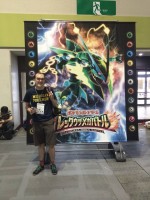 Let me remind you that the format for all major tournaments in Japan is still BW-On, the equivalent of the West’s Expanded format. With this in mind, my deck of choice was Night March with Maxie's Hidden Ball Trick and Archeops. I have always been a huge fan of decks that operate in such a unique way that they seem like complete gimmicks at first, because in my experience, they almost always wind up being very powerful if played correctly (as long as they focus on Basic Pokemon, anyways – RIP all my dreams for Cradily).
Let me remind you that the format for all major tournaments in Japan is still BW-On, the equivalent of the West’s Expanded format. With this in mind, my deck of choice was Night March with Maxie's Hidden Ball Trick and Archeops. I have always been a huge fan of decks that operate in such a unique way that they seem like complete gimmicks at first, because in my experience, they almost always wind up being very powerful if played correctly (as long as they focus on Basic Pokemon, anyways – RIP all my dreams for Cradily).
I piloted Arceus with a fair amount of success, I knew how dominant Durant would be as soon as the Japanese Red Collection spoilers hit, and I had a sneaking suspicion Night March would be the same way. With this in mind, combined with the fact that it was a relatively cheap to build (since English cards aren’t allowed in Japan, I had to start my collection from scratch in Japanese), I’ve been playing Night March exclusively since Phantom Gate (Japan’s equivalent of Phantom Forces) came out last October.
For many months, I stubbornly held fast to the notion that the Gourgeist / Celebi-EX variation was the best, because it’s hard not to be impressed by a hard-hitting 200 HP one-prize behemoth that resists the Fighting decks that were so popular earlier this season. With this variant, I met with moderate success at various Gym Battles, winning a couple of them, but performed quite poorly at the one Battle Festa I attended. I changed my tune when I saw how well US players were doing at States with the completely unexpected addition of Archie's Ace in the Hole and Empoleon, and began playing that variation, which I found ran much much smoother.
When Emerald Break (equivalent to Roaring Skies) came out here and both types of M Rayquaza-EX gained popularity, I realized something about the format – almost all of the popular decks relied on Evolved or Mega Evolved Pokemon for their major firepower. I was particularly afraid of how much harder a turn one Altaria could make a match against the Colorless Rayquaza, so I tweaked the deck slightly to hopefully prevent that from happening, replacing the Archie’s Empoleon and a couple other cards with two Maxie's Hidden Ball Trick and two Noble Victories's Archeops. In my testing online, I had an Archeops on the board turn one around 60% of the time, and by turn two at least 80% of the time. I liked those odds, so I ordered a pair of Archeops and prepared my deck for the real thing. Here’s the list I used:
Pokemon (18) |
Trainers (33) 4x Professor Sycamore (XY #122) 2x Maxie's Hidden Ball Trick (PRC #133)
4x Battle Compressor (PHF #92)
|
Energy (9) |
If I were to change anything, I probably would have cut one of the Muscle Bands for something more useful, as I don’t think I ever needed all three. There were also times when I had more Energy than I needed, so maybe I’d cut a Muscle Band and a basic Energy for two Trainers' Mail, or something. The Pokemon line is exactly where it should be in my opinion: I don’t find Mr. Mime to be at all necessary in the current metagame; and I find Jirachi-EX to be immensely better than Shaymin-EX in this deck, because grabbing a Supporter allows a far more versatile range of effects – Lysandre, Maxie's Hidden Ball Trick, or Teammates all do crucial potentially game-winning things that Shaymin can’t hope to match. And if you want to use Sky Return with Mew, don’t worry, your opponent will almost always have a Shaymin on the field you can use. Enough about my deck, though, since it’s only viable in Expanded and most of you are probably sick of hearing about Night March at this point anyways. Onto the tournament.
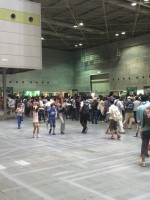
I arrived at the tournament venue nearly an hour early to find that an enormous snaking line, hundreds and hundreds of people long, had already formed outside the entrance. So far, it’s just like US Nationals, I thought. Once I eventually made my way in, however, those similarities quickly dissipated. Once I made my way through security and received my promo card just for showing up (at these events it was Swampert-EX; at the Battle Festa it was that sweet full-art Pikachu that’s probably never getting an English release), I headed immediately for the “Last Challenge” tournament area, eager to go wait in another line.
The first portion of the Rayquaza Mega Battle was essentially two different tournaments taking place simultaneously. Players who had earned a victory certificate by winning specially designated “Rayquaza Gym Battles” in March could exchange it for entry into the Rayquaza Mega Battle, an ordinary single elimination tournament starting promptly at 9:00 and grouped into pods based on the total number of people showing up, with the winner of each pod earning a place in the Final Tournament. For those of us without a certificate, all hope was not lost, however: we still had a chance to make it to the Final Tournament by playing in the “Last Challenge,” which consisted of a much more Japan-exclusive format (which was also used at the Battle Festas).
While US tournaments sometimes mean players waiting in their seats for a long time while the judges work out the latest TOM bug, I’ve learned this year that Japanese tournaments always mean players waiting in line for a long time for a chance to play. The Last Challenge tournament ran from 9:00 AM-1:00 PM, with entry permitted at any time during that window by joining the back of the line. In line, you’re waiting for a spot to open up at one of a designated number of tables in the First Stage area, which are far far fewer than the number of people trying to participate in the tournament. Hope you brought your 3DS, because you’re going to be waiting a while.
Once you get to the front of the line, you’ll be directed to an open table to play against someone who just won their last game. If you defeat them, you get to stay at the table. If you lose, back to the end of the line for some more waiting. If you manage to win two games in a row, you’ll move on to the smaller Second Stage area, populated entirely by players who have accomplished the same feat. Here, if you manage to win another three games in a row, you’re granted entry to the Final Tournament, assuming there are still spaces open (there were a total of 52). If you lose even once… back to the end of the First Stage line. So, participants in the Last Challenge have to win five games in a row in order to secure entry into the Final Tournament, which as you might have guessed, is Single Elimination. Japan’s career-defining tournaments are not as forgiving as the Swiss rounds of the US; here, victory means an undefeated record. This tournament format also explains the speed with which Japanese players play, which many Westerners find amazing – “stalling” does not exist here because, at least in the qualifying stage, rounds are not timed, and you want to get the game over with as quickly as possible because if you lose, you need to quickly get back in line so you might have another shot at a winning streak before the First Stage time window closes. And as I soon learned, even one loss drastically reduces the chances of that happening.
Attempt One, Game One
vs. Raichu / Shiftry / Shaymin-EX / Virizion-EX
Turn one, he N’d me into a near-perfect hand – two Battle Compressors, a VS Seeker, and a handful of other cards I could play to get my hand down into Maxie range, which I knew would essentially win me the game right then and there, because what were Pikachu and Seedot going to do to me? Unfortunately, when I went to compress the necessary cards, I discovered that I must not have shuffled well enough – both my Maxie's Hidden Ball Trick (PRC #133) were prized. I was still able to take my first Night March KO turn two, though, so I rolled with what I had. He hit me with a Lysandre's Trump Card early on, but I partially recovered, and we continued to progress at a roughly equal pace, due largely to the blessing that it took him a far longer than average to get a Shiftry out. It came down to my two Prizes (both Maxie’s) remaining vs his one, and I was facing down a clean Shiftry with only one Marcher in my discard. But I topdecked exactly what I needed, a Battle Compressor, which I used to ditch two more Marchers and a Lysandre, VS Seeker’d the latter to bring up his Shaymin-EX and hit it for 120 with a Joltik for my last two Prizes.
Attempt One, Game Two
vs. Seismitoad-EX / Garbodor / Shaymin-EX
Believe it or not, since the addition of Shaymin-EX, Seismitoad is not a hopeless match for Night March. The key is, if you can’t get enough Marchers in the discard pile, don’t even bother with your own attacks – use theirs. Two Mew and a DCE (or a basic Energy and a Dimension Valley) is all you need. Quaking Punch, Quaking Punch, Sky Return, rinse, repeat. Locking their items means they can’t hammer your energy (except on the turn when it’s back in your hand anyways) or use Hypnotoxic Laser to KO you quicker than expected, and you can just keep building up the damage on them and Sky Return in time to prevent them from KO’ing one of your Mew. It’s not a perfect strategy, but it works decently well. Unless, of course, they manage to get Head Ringers on both of your Mew and N away your energy, as my opponent did in this game, making the strategy a bit more difficult to sustain. I missed a turn of attack and he had a Float Stone on his Garbodor (because, again, the Maxie’s Archeops combo that seemed so consistent in testing was suspiciously unattainable), at which point I forfeited.
Back to the end of the line!
Attempt Two, Game One
Again, Archeops eluded me, allowing him to get several of the deck’s signature attackers out in addition to the Hawlucha and Robo Substitute. After a couple of Lysandres, I had 11 Night Marchers in my discard pile and the last one in my Prizes, giving my Mew-EX no means to use my deck’s namesake attack. Well, that was okay. If I couldn’t use my own attacks, I’d use his. Dropping Empoleon meant I wasn’t restricted to Water Energy, so I converted that to a split of the types used in the decks I expected to give me the most trouble, Fighting and Dark. I got two Fighting and a DCE on one Mew and one Fighting on another, and the games began. Spinning Turn killed his Robo Subs while keeping me out of KO range, and Wreck OHKO’d his Donphan when I was able to Lysandre them. Unfortunately, two of my VS Seeker fell victim to an early game Professor Sycamore, so I couldn’t Lysandre enough times to take care of all his Donphan. Not to mention, I burned through so many cards that I was worried I was going to deck out by the end – there were only four cards left in my deck when we finished. We got down to two prizes left each, and I had three Mews on the board to work with and Spinning Turn/retreat out of KOs, but he Lysandre’d up a damaged one for the game. A very close, very good game that forced me to think outside the box and use a different strategy from normal.
By this point it was already 11:45, and I knew the wait in line would be at least 30 minutes. Realistically, there was no way I was going to make it to the Final Tournament, even if I won from here on out. So instead, I decided to grab lunch and explore the other areas of the event.
It was also at this point that I realized I’d been doing the Japanese shuffle improperly, which almost certainly led to my inability to pull off Archeops. Japanese players, with absolutely zero exceptions as far as I have seen, ten-pile their decks, then stack those piles on top of each other, then riffle shuffle the result several times. When done properly, this is a far better method of randomization than any of the popular Western shuffles. I was messing this up, however, by doing mini riffle shuffles with sets of two of the piles first – which effectively placed pairs of the same cards right back next to each other. Whoops. Well, it was a lesson I could take into the side events, at any rate, and one I encourage all of you to try out if your current shuffling method is giving you a bunch of dead opening hands!
Because the side events used the same space as the first stage of the Mega Battle and Last Challenge, they didn’t start until 1:30, so I bided my time by walking around and exploring the other areas of the event hall, including:
- Main Stage: Here, Pokemon-related videos were playing on a screen throughout the day, and special events would occasionally occur – for example, at one point, event staff cosplaying as four of the Hoenn Gym Leaders showed up to play some kind of game with the children, after which they wandered around the hall taking pictures with people for the rest of the day.
- Tag Battle: A side event that was running all day, in which a team of two players used one deck. Every other turn, you would switch out and have your teammate take a turn. Because this wasn’t a very serious format of competition, the prizes were just small things like stickers.
- Mini Games: Probably the most uniquely Japanese section of the event. Here, participants could play simple mini games to win small prizes like stickers and coins. In one game, you flipped an oversized Rayquaza coin 5 times, and if you got 3 or more heads, you received a play-sized version. In another, you opened one of your own booster packs in hopes of pulling one of the specified types of cards (Pokemon with 60 HP, Stage 1 Pokemon, Stadium Card, Special Energy, etc), and got stickers if you succeeded. In the third, you presented one of your Pokemon cards and chose one of its attacks, then did a ring toss onto a 3×3 board comprised of the energy symbols to try to land each symbol of that attack’s cost, and received stickers if you managed it. As you might expect, these mini games primarily attracted parents and younger players, but I found them an enjoyable way to pass the time.
-
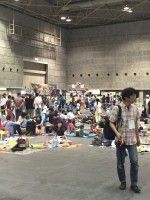
A view of some other activities Pokemon Tretta – There was also a tournament-type event going on in one corner for Pokemon Tretta, an arcade game in which you scan square-shaped discs depicting Pokemon which appear to fight for you in the game. It’s an interesting novelty, but lacks any real depth (as the stats of each disc are static) and, as far as I can tell, is more about collectibility than actual gameplay.
- Artist Signing – Much like at Worlds, several of the TCG’s artists were there at certain times of day to sign cards and other items.
- Merchandise Corner: In addition to selling all the most recent card packs, the merchandise corners at these events also sell some event-exclusive items, like deck boxes, pins, and special blister packs containing packs and promo cards – in this case, a Blaziken-EX and a coupon that could be redeemed at the Prize Corner for a M Blaziken-EX.
- Prize Corner: All players, upon entry into the venue, receive a Point Sheet. By participating in the main event and various side events, they earn stamps on this point sheet, which can be redeemed at the Prize Corner for promo cards (and, if you get enough of them, exclusive T-Shirts). At the Battle Festa, 12 points got you Absol-EX and M Absol-EX; here, 9 points got you M Swampert-EX and 3 points got you a random one of the eight Gym Badge cards depicting the Hoenn Gym Leaders. Players could also bring in three point cards acquired in random Emerald Break packs to exchange them for a Shiny Rayquaza-EX promo.
- Trade Station: This was a booth unique to this event. Here, players could bring the Gym Badge cards they had gotten from the Prize Corner and exchange them for another random one, theoretically repeating the process indefinitely until you got the badge you wanted. Seemed like a strange system to me, but maybe it was a way to mitigate lines, because, much like the main tournament, every single area of the event hall was flanked by a long one.
- Free Play Area: Pretty much exactly like it is at US events.
After I’d explored a bit, I headed back to the tournament area, where they were setting up the two side events that would occur simultaneously with the Final Tournament. The first was the “3-on-3 Battle,” where, as you might have guessed, teams of three players play alongside each other with victory going to a team that wins two or more of those games. The other was the “Knockout Battle,” which was basically just playing single games for points – people are accepted from the line two at a time, sit down and play a game; the winner receives 2 stamps on their Point Sheet and the loser gets nothing, and both go back to the end of the line. Because no one remains at a table after a game, and because the area was quite large, this line moved much, MUCH faster than the Last Challenge line did, and I got to play quite a few games.
Game One
vs. Raichu / Roserade / Milotic / Ninetales / Shaymin-EX
Now this was an interesting deck. A Sky Field-powered Raichu as the main attacker, with a bevy of coming into play powers for support, with Devolution Spray to renew the abilities. If Broken Time-Space existed in this format, I would absolutely love to play a deck like this (with other possible additions of Crawdaunt and Forretress or Crobat), but without it, there are some major weak points. I got Archeops in play on turn three, at which point my opponent immediately scooped.
1-0
Game Two
vs. M Rayquaza-EX / Shaymin-EX
He only got one M Rayquaza-EX down before I got Archeops, and it was fairly easy to fill the discard pile to the point where Joltik could OHKO everything in the absence of Altaria (RSK #74). I took all six Prizes fairly quickly.
2-0
Game Three
vs. Landorus-EX / M Manectric-EX / Garbodor
I got Archeops out turn one, preventing him from evolving his Manectric-EX or Trubbish. It was still a close game, as Landorus-EX and Manectric have a fair amount of firepower without the need to evolve, but I outpaced him on KOs and won in the end.
3-0
Game Four
vs. Fairies
Once again, got Archeops out on turn one, blocking his Aromatisse. I had enough Night Marchers in the discard pile to OHKO his Xerneas-EX on turn two, and proceeded to OHKO everything else he sent up at me from there.
4-0
Game Five
vs. Primal Kyogre-EX / Huntail
An early Archeops would have made this game a quick win, but the prehistoric bird didn’t manage to hit the field until far too late in the game, when he already had two Primal Kyogre and two Huntail in play. We got down to my two Prizes remaining versus his three, with 10 Night Marchers in my discard pile and two Joltiks and a Mew on the field. I sent up a Joltik, knowing that when he KO’d it, I could put a Muscle Band on Mew or the remaining Joltik for the 240 damage necessary to KO Primal Kyogre-EX for the game. Instead, he Lysandre‘d Mew and KO’d that instead, making my remaining Joltiks max out at 220 damage, leaving me unable to OHKO him before he KO’d a Joltik for his last prize. The guy was very cheerful and animated in that way that made me think he could have been a Japanese game show host, and we had a ton of fun with the game, so it was a loss that I did not mind one bit.
4-1
Game Six
vs. Shiftry / ?
Two Battle Compressor turn one gave me five Marchers in the discard pile and an Archeops on the field, though this was a bit unnecessary, because I just KO’d his lone Seedot.
5-1
Game Seven
vs. Fairies w/ techs (Malamar-EX, Keldeo-EX, etc)
Once again, I got Archeops out turn one. Much to my surprise, she responded with an Evosoda, circumventing the blockade to get Aromatisse into play. I outpaced her, however, getting just enough Marchers in the discard pile for each KO and waking up from Malamar’s hypnosis just when I needed to, taking one to two Prizes every turn until I won.
6-1
Moral of the story: Make sure you’re properly randomizing your deck before the main tournament, not so late that it only benefits you in a side event without much prize support (Though I suppose, in a US side event, I might have scored a fair number of packs with this 6-1 record, but here it just meant enough points for a M Swampert-EX and three Gym Badge cards). I wasn’t really expecting to win the tournament or anything, though, nor was it my goal to do so. My goal was to play a lot of Pokemon and have a lot of fun, and I definitely accomplished that.
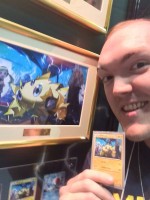
Some thoughts on Japan’s metagame versus ours, after the tournament:
- For the most part, it’s largely very similar. I think people tend to assume it’s radically different, but generally, when the newest set is the same, there are more similarities than differences. Most of the decks I encountered were the same ones that are popular right now in the US.
- Lock decks are a lot less prevalent, but not nonexistent. Exeggutor doesn’t really exist here at all (I didn’t see a single one all day), and I didn’t see much Wally‘s Trevenant either, but I think there were a couple. Seismitoad-EX may not be quite as popular as it is in the US, but it’s still very much prevalent, with an additional variant available in the form of Seismitoad / Musharna, which took 3rd place at the tournament.
- There were two Raichu / Crobat / Shaymin-EX decks in the top 8, a combination which I don’t think is popular in the US but which seems like a strong non-EX deck in the current format.
- There was a surprising amount of Shiftry. I expect it will only get more prevalent when Giant Plant Forest comes out in the next set, and I’m guessing it may catch on in the West then, too.
Of course, who knows how the format will shift with Bandit Ring coming out in a couple weeks, and with the recent ban on Lysandre's Trump Card – a ban which I’ve heard some games at this tournament were largely responsible for. The card was abused here in all the same ways as it was in the West, and it will be interesting to see how players in both markets adapt to its absence. There are other articles here on PokeBeach you can read for more about that, though. For my part, I hope you enjoyed this insight into the Distortion World that is Organized Play in Japan! If you have any more questions about playing Pokemon in Japan, the Rayquaza Mega Battle, or my deck, please ask away in the comments below!


